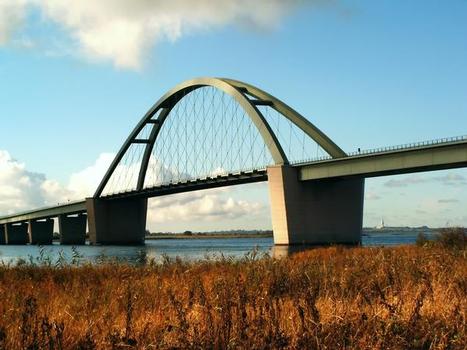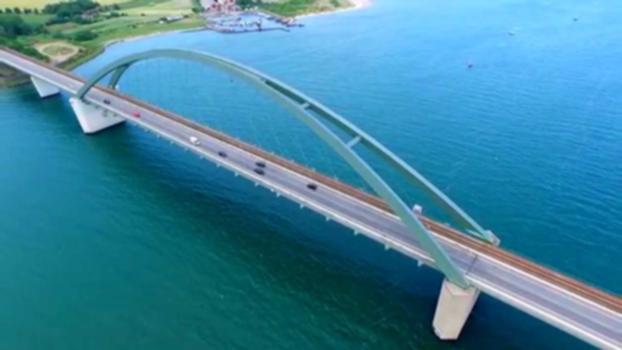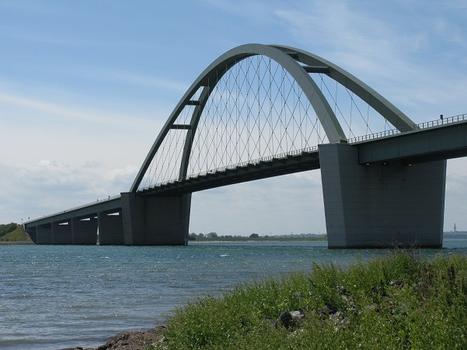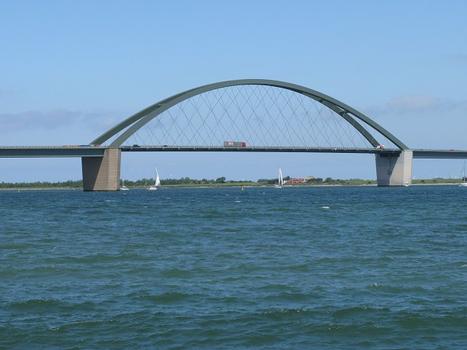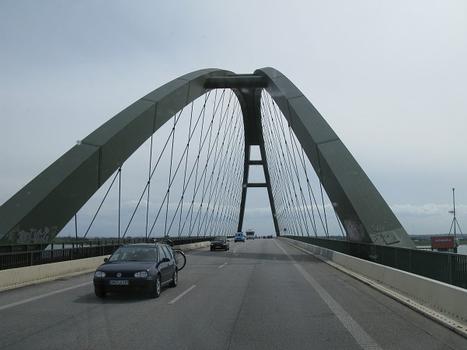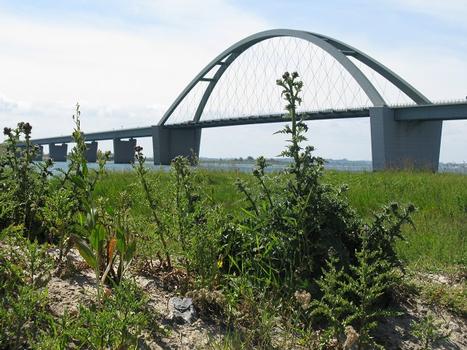General Information
| Name in local language: | Fehmarnsundbrücke |
|---|---|
| Beginning of works: | 4 January 1960 |
| Completion: | 30 April 1963 |
| Status: | in use |
Project Type
| Structure: |
Network arch bridge |
|---|---|
| Function / usage: |
Road bridge Railroad (railway) bridge |
| Material: |
Steel bridge Structurae Plus/Pro - Subscribe Now! |
Location
| Location: |
Großenbrode, Ostholstein, Schleswig-Holstein, Germany Fehmarn, Ostholstein, Schleswig-Holstein, Germany |
|---|---|
| Crosses: |
|
| Coordinates: | 54° 23' 47.21" N 11° 6' 32.52" E |
| Coordinates: | 54° 24' 16.69" N 11° 6' 51.91" E |
Technical Information
Dimensions
| length of side spans | 120 m | |
| total length | 963.40 m | |
| clearance | 23 m | |
| arch | rise | 43 m |
| arch span | 248.40 m | |
| deck | deck width | 20.95 m |
Quantities
| structural steel | 9 200 t |
Design Loads
| live load | Brückenklasse 60 / Lastenzug S |
Materials
| deck |
steel
|
|---|---|
| piers |
reinforced concrete
|
| arch |
steel
|
| suspenders |
steel wire
|
| abutments |
reinforced concrete
|
Chronology
| 30 April 1963 | Inauguration of the bridge. |
|---|---|
| 14 May 1963 | Inauguration of Puttgarden station and the entire rail line. |
Excerpt from Wikipedia
The Fehmarn Sound Bridge (German:Fehmarnsundbrücke) connects the German island of Fehmarn in the Baltic Sea with the German mainland near Großenbrode.
Description
The 963-metre-long (3,159 ft) crossing includes the 248-metre-long (814 ft) network arch bridge which carries road and rail over the 1,300-metre-wide (4,265 ft) Fehmarn Sound. Construction began in 1958 and the bridge was opened on April 30, 1963. The main span is 22 metres (72 ft) above the sea, which allows shipping to pass through. The bridge is constructed of steel and is 21 metres (70 ft) wide; 6 metres (20 ft) are used by Deutsche Bahn for a single rail track, part of the Lübeck–Puttgarden railway, the rest for a pedestrian walkway and two-lane roadway. The two steel arches, from which the central span is suspended by cables, are braced with steel cross-beams. The arches are 248 metres (810 ft) in length and reach 45 metres (150 ft) above the main deck of the bridge. The bridge was designed by engineers G. Fischer, T. Jahnke und P. Stein from the firm Gutehoffnungshütte Sterkrade AG, Oberhausen-Sterkrade. Architect Gerd Lohmer helped with the architectural design.
Route and ferry changes
At the same time as the opening of the bridge, changes were made to ferry services. The previous ferry service to the island of Fehmarn was discontinued. The service from Großenbrode Quay, Germany to Gedser, Denmark, crossing both Fehmarn Sound and the Fehmarn Belt, was replaced with a new service from Puttgarden (on Fehmarn) to Rødby, Denmark crossing just the Fehmarn Belt. The new bridge and ferry changes brought about a substantial time saving for both road and rail traffic along the so-called Vogelfluglinie (literally "bird flight line") from Hamburg to Copenhagen.
Historic monument
The Fehmarn Sound bridge was declared an historic monument in 1999 by the State Office for Protection of Historical Monuments of Schleswig-Holstein in Kiel, and has since become a symbol of both Fehmarn and Schleswig-Holstein.
Cold War explosive charges
As the bridge was built during the Cold War, six explosive vaults were embedded below the approach road on the mainland side to be used in case of invasion. Their location is given away even today by six square asphalt patches. The vaults were connected to a control point about 1 km (0.6 mi) away in Heinrichsruh.
Text imported from Wikipedia article "Fehmarn Sound Bridge" and modified on July 22, 2019 according to the CC-BY-SA 4.0 International license.
Participants
-
Gutehoffnungshütte Sterkrade AG
- Helmut Wild (chief engineer)
- Philipp Stein (engineer)
- T. Jahnke (engineer)
- Stoltenburg (engineer)
- G. Fischer (engineer)
- Hans Krüßmann (engineer)
- Gerd Lohmer (architect)
Relevant Web Sites
Relevant Publications
- (1965): Das Bogentragwerk der Fehmarnsundbrücke. In: Stahlbau, v. 34, n. 6 (June 1965), pp. 171-186.
- (1999): Die Brücke über den Fehmarnsund. In: DenkMal!, v. 6 ( 1999), pp. 88+.
- (2006): Brücken in Deutschland für Straßen und Wege. Der Fotobildband deutscher Brückenbaukunst. Deutscher Bundesverlag, Cologne (Germany), ISBN 978-3-935064-41-5, pp. 90-91.
- (1984): Buiding bridges. History, Technology, Construction. Beton-Verlag, Düsseldorf (Germany).
- (1960): Ergebnis des Wettbewerbs Fehmarnsundbrücke. In: Eisenbahntechnische Rundschau, v. 9, n. 5 ( 1960), pp. 191.
- About this
data sheet - Structure-ID
20001776 - Published on:
19/08/2001 - Last updated on:
14/11/2017

